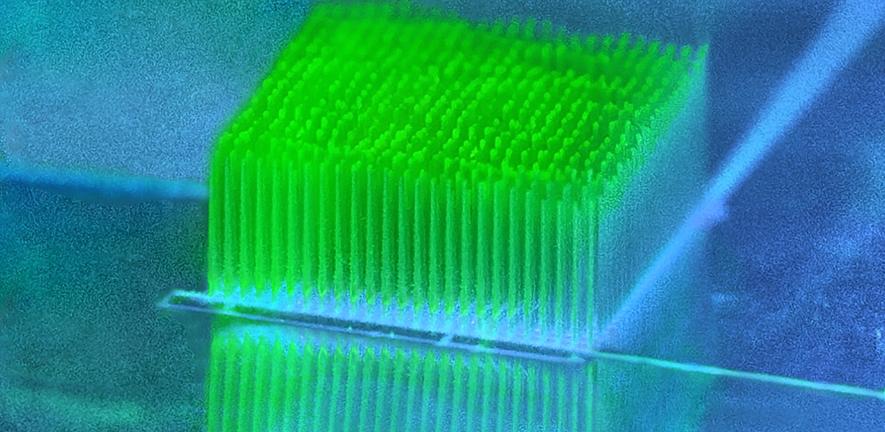A team of researchers from the University of Cambridge has come up with a novel method combining 3D printing and blue-green algae that could help boost sustainable bio-electricity and fuel generation in the future.
The researchers 3D printed tiny electrodes in structures similar to that of a high-rise apartment block in order to provide an optimal environment for blue-green algae, a photosynthetic bacteria that has inspired promising avenues of research into renewable energy, to rapidly grow and boost its energy-harvesting potential.
“Our approach is a step towards making even more sustainable renewable energy devices for the future,” said Dr. Jenny Zhang of the University of Cambridge’s Yusuf Hamied Department of Chemistry, and research lead. “There’s been a bottleneck in terms of how much energy you can actually extract from photosynthetic systems, but no one understood where the bottleneck was.
“Most scientists assumed that the bottleneck was on the biological side, in the bacteria, but we’ve found that a substantial bottleneck is actually on the material side.”
Photosynthetic systems for renewable energy
The Cambridge team says its approach is competitive against more traditional methods of renewable bioenergy generation, having already matched solar conversion efficiencies that can reportedly surpass many current methods of biofuel generation.
3D Printing Industry’s ongoing interview series is looking at low carbon power generation and 3D printing and renewable energy, sharing insights from Oak Ridge National Laboratory (ORNL) on the application of additive manufacturing in nuclear energy, and GE Renewable Energy on how the technology is benefiting the wind energy sector. So far, the series has also explored how 3D printing is enabling the creation of next-generation solar cells, and the role additive could play in bringing the hydrogen economy closer to reality.
While current renewable energy technologies are far superior to fossil fuels in terms of carbon emissions, they also have their limitations. For instance, some still have a heavy reliance on mining, farming and land use, while others face challenges around recycling.
Cyanobacteria like blue-green algae, however, produce energy through photosynthesis and therefore offer a promising avenue of research into renewable energy generation without many of these drawbacks. The bacteria, which are the most abundant life form on Earth, can be found in all types of water, and use sunlight to make their own food.
Through their latest study, the Cambridge team sought to harness the energy produced by the bacteria by growing them on specially-designed structures made up of 3D printed electrodes.

A 3D printed “nano-housing” community
Researchers have been attempting to “re-wire” the photosynthetic mechanisms of cyanobacteria in order to extract energy from them for some time. However, in order to extract the energy produced by blue-green algae via photosynthesis, the bacteria need to be attached to electrodes.
The Cambridge team 3D printed electrodes comprised of metal oxide nanoparticles specially tailored to be compatible with blue-green algae as it performs photosynthesis. The electrodes were printed in a densely packed structure that resembled a tiny city of skyscrapers, in order to provide an optimal environment to stimulate their growth.
“The electrodes have excellent light-handling properties, like a high-rise apartment with lots of windows,” said Zhang. “Cyanobacteria need something they can attach to and form a community with their neighbors. Our electrodes allow for a balance between lots of surface area and lots of light – like a glass skyscraper.”
Once the blue-green algae started to grow in its new environment, the researchers were able to extract the waste energy left over from the photosynthesis process which could be used to power small electronic devices.
The researchers found that the bacteria were more efficient at producing energy than other current bioenergy technologies, such as biofuels. The technique increased the amount of energy extracted by “over an order of magnitude” over other methods for producing bioenergy from photosynthesis.
“I am surprised we were able to achieve the numbers we did – similar numbers have been predicted for many years, but this is the first time that these numbers have been shown experimentally,” said Zhang. “Cyanobacteria are versatile chemical factories. Our approach allows us to tap into their energy conversion pathway at an early point, which helps us understand how they carry out energy conversion so we can use their natural pathways for renewable fuel or chemical generation.”
Further information on the study can be found in the paper titled: “3D printed hierarchical pillar array electrodes for high-performance semi-artificial photosynthesis,” published in the Nature Materials journal. The study is co-authored by X. Chen, J. Lawrence, L. Wey, L. Schertel, Q. Jing, S. Vignolini, C. Howe, S. Kar-Narayan, and J. Zhang.
Subscribe to the 3D Printing Industry newsletter for the latest news in additive manufacturing. You can also stay connected by following us on Twitter and liking us on Facebook.
Looking for a career in additive manufacturing? Visit 3D Printing Jobs for a selection of roles in the industry.
Subscribe to our YouTube channel for the latest 3D printing video shorts, reviews and webinar replays.
Featured image shows the University of Cambridge’s 3D-printed custom electrodes. Photo via Gabriella Bocchetti.


